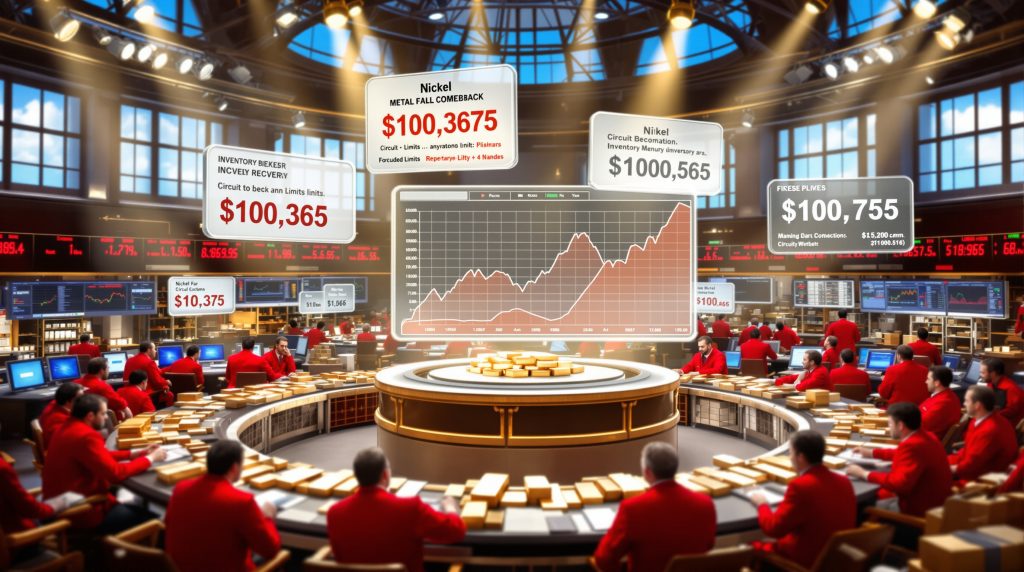The Nickel Crisis That Nearly Destroyed the LME
In March 2022, the London Metal Exchange faced an unprecedented crisis when nickel prices surged over 250% in just 24 hours, reaching a record $101,365 per metric ton. This extreme volatility forced the exchange to suspend trading and controversially cancel $3.9 billion worth of trades. The market disruption threatened the very existence of the 148-year-old institution and severely damaged trust among traders and industrial users.
The crisis stemmed from a significant short squeeze involving Chinese stainless steel producer Tsingshan Holding Group, which had accumulated a substantial short position in nickel futures. When Russia invaded Ukraine on February 24, 2022, concerns about nickel properties insights and supply disruptions triggered price increases that forced short-sellers to cover positions, creating a self-reinforcing spiral.
How the crisis damaged LME's reputation
The nickel market collapse represented the most significant threat in the exchange's history, with many market participants withdrawing from trading activities. Trading volumes plummeted, particularly in nickel contracts, as industrial users sought alternative pricing mechanisms and institutional investors questioned the exchange's risk management capabilities.
The crisis attracted intense regulatory scrutiny, with both the Financial Conduct Authority (FCA) and Bank of England launching formal investigations into the LME's governance and market oversight. According to the FCA's investigation findings, the exchange's decision to suspend trading and cancel executed trades represented "an unprecedented intervention in a major financial market" that raised significant questions about market integrity and investor protection.
The Exchange's Path to Recovery
Following the crisis, the LME embarked on an extensive reform program addressing market structure, risk management, and governance. Key changes included:
- Introduction of daily position reporting requirements for OTC trades linked to LME prices
- Implementation of enhanced 15% daily price limit circuit breakers across all metals
- Strengthened surveillance systems with particular focus on Asian trading hours
- Improved transparency around dominant market positions
- Extension of lending rules beyond cash dates to nearest monthly prompts
The LME implemented a 15% daily price limit across all base metals contracts effective from May 2022. This circuit breaker mechanism automatically pauses trading if prices move beyond the threshold within a single trading day, providing time for market participants to assess conditions and manage risk.
Beginning in 2023, the exchange introduced daily position reporting requirements for over-the-counter (OTC) trades that reference LME prices. This enhanced transparency measure allows the exchange to monitor concentrations of market positions across both on-exchange and off-exchange trading.
Financial recovery and volume resurgence
The LME's financial performance has rebounded significantly according to Hong Kong Exchanges and Clearing (HKEX) financial reports:
| Metric | 2022 (Crisis Year) | 2024 | Change |
|---|---|---|---|
| Total Trading Volume | Significant decline | +18% year-on-year | Strong positive |
| Combined Pre-tax Profit (LME/LME Clear) | Depressed | $193 million | +68% year-on-year |
| Nickel Trading Volume | Severely impacted | +58.8% | Return to pre-crisis levels |
Through the first nine months of 2025, LME average daily volumes increased an additional 3% compared to the same period in 2024. By late 2024, nickel trading volumes had returned to pre-crisis levels, with institutional participation fully restored. The exchange achieved its strongest overall trading activity since 2015, marking the fourth-highest volume year in its history.
Market Dynamics Fueling the Comeback
Ironically, the LME has benefited from turbulence in physical metal markets. The exchange has reaped the reward of turmoil in physical metal supply chains that have reinforced its role as the global benchmark for industrial metals pricing.
Physical metal supply chain disruptions
Several market disruptions have driven activity back to the LME:
-
Copper market upheaval: US President Donald Trump's threat to impose 50% import tariffs on refined copper triggered a massive inventory shift to American shores. This benefited the LME's international contract while reducing CME activity by 39%. LME copper futures and options volumes increased 2.4% year-over-year through September 2025, while CME volumes contracted substantially. Additionally, recent copper price prediction reports have attracted more trading interest.
-
Lead and nickel oversupply: Global lead production has exceeded consumption in 2024-2025, resulting in increased flows into LME warehouses. Similarly, excess nickel production has increased LME warehouse stocks to multi-year highs, enhancing financing activity where traders purchase physical metal, store it in LME warehouses, and sell forward to profit from the price structure.
-
Aluminum market squeeze: A prolonged tightness in the aluminum market since May 2025 has attracted trader interest despite regulatory attention. The squeeze has been characterized by sustained backwardation (where spot prices trade above future prices), indicating tight near-term physical availability despite healthy overall global inventories. The Financial Conduct Authority has been investigating Swiss trading house Mercuria Holdings' position in the LME aluminum market.
Inventory improvements supporting market confidence
A critical factor in the LME's nickel market recovery has been the substantial increase in exchange inventory:
| Period | LME Nickel Inventory (metric tons) |
|---|---|
| Mid-2023 | Under 40,000 |
| Late 2024 | Nearly 230,000 |
| Current (2025) | Multi-year highs above 200,000 |
This inventory expansion has addressed concerns about potential squeezes and improved market liquidity, allowing industrial users to confidently return to the exchange. The availability of physical metal for delivery has restored the credibility of the contract as a reliable price discovery mechanism.
Regulatory Resolution and Ongoing Challenges
FCA investigation outcomes and penalties
In early 2025, the Financial Conduct Authority concluded its investigation into the nickel crisis, imposing a £9.2 million (approximately $11.6 million USD) fine on the LME for regulatory failures. While significant, the penalty was reduced for cooperation, and the detailed regulatory report provided a roadmap for continued improvement.
The FCA's investigation concluded that the LME failed to ensure its systems and controls were appropriate for the orderly operation of its facilities. Specifically, the regulator found that:
- The exchange's rulebook did not contain sufficiently clear provisions for suspending trading or canceling trades in extreme circumstances
- Governance arrangements were inadequate for making decisions of such significance under time pressure
- The LME did not have adequate arrangements to monitor and manage the risks associated with concentrated positions
The resolution of this regulatory uncertainty has further supported the exchange's recovery.
Balancing reform with member interests
The LME continues to navigate tensions between reform imperatives and member preferences:
-
Block trade thresholds: After extensive consultation with members, the LME announced in 2024 that it would implement block trade thresholds designed to direct more liquidity to its electronic trading platform (LMEselect). However, the exchange made concessions allowing greater flexibility for inter-office trading in the front part of the forward curve to maintain support from industrial users.
-
OTC market oversight: Plans to extend block-trade rules to OTC markets were abandoned after strong resistance from both members and futures industry associations. Instead, the LME introduced increased fees for "lookalike" OTC contracts that reference LME prices but are executed off-exchange.
-
Options market development: The LME has initiated a gradual transition of its options contracts from inter-office (telephone-based) trading to electronic execution on LMEselect. This modernization effort aims to increase transparency and attract new participants, particularly algorithmic traders and market makers like Optiver, which became a non-clearing member in 2025 specifically to trade LME options electronically.
Global Expansion and New Opportunities
Warehouse network expansion
The LME has strategically expanded its global warehouse network, opening new facilities in:
- Saudi Arabian port of Jeddah (first approved storage location in the Middle East)
- Additional warehouse capacity in Hong Kong
This expansion reflects strategic positioning to serve growing metals demand in Asia and the Middle East. These locations also provide alternative storage options as trade war impacts have complicated traditional metal flows through European and North American logistics chains.
Revitalization of dormant contracts
Several previously inactive contracts have found new life amid market volatility:
-
The cobalt contract has reached record trading volumes in 2024-2025, supported by 1,755 tons of metal entering LME warehouses. The contract, which trades in lots of 1 metric ton of cobalt cathodes with minimum purity of 99.3%, had seen minimal activity for much of its existence since launching in 2010.
-
Aluminum alloy trading has increased with new participants entering the market. The contract allows for delivery of primary aluminum alloy meeting specific compositional standards, providing price exposure distinct from primary aluminum.
-
Options trading across multiple metals has grown as the exchange works to develop this segment. The LME's options market has historically been underdeveloped compared to peer exchanges like the Shanghai Futures Exchange and CME.
Continued relevance of the trading ring
Despite predictions of its demise, the LME's open-outcry trading ring continues to operate, with US broker Clear Street recently joining the circle. This traditional trading mechanism maintains support from industrial users who value its role in establishing official settlement prices through a five-minute trading session for each metal.
What's Next for the LME?
Can the exchange maintain its momentum?
The LME's recovery appears robust, but challenges remain:
-
Ongoing competition from the Shanghai Futures Exchange, which has developed liquid options markets across its metals suite since introducing options trading in 2018. ShFE now offers options contracts across its full metals suite, including copper, aluminum, zinc, lead, nickel, tin, and aluminum alloy.
-
The CME Group has expanded its copper derivatives offering by introducing weekly options contracts, providing traders with more granular hedging and speculation tools compared to traditional monthly or quarterly options.
-
Following the United Kingdom's departure from the European Union, UK financial regulators including the FCA have been reviewing financial market structures to ensure competitiveness while maintaining robust oversight.
-
The LME must continue balancing the needs of its traditional industrial user base (metals producers, fabricators, and consumers seeking physical price hedging) with modern electronic trading preferences of financial participants.
The copper price rally as a catalyst
As the global metals industry gathers for LME Week 2025, copper prices have surged to near all-time highs, approaching the $11,104.50 per metric ton record set in May 2024. Current prices around $10,780 per metric ton indicate strong bullish sentiment. This bull market in the exchange's flagship contract is likely to further energize trading activity and cement the LME recovery from nickel crisis.
What Lessons Can Other Exchanges Learn?
Crisis management and market integrity
The LME experience offers valuable lessons for other exchanges:
- The critical importance of robust circuit breakers and position monitoring
- The need for transparent decision-making during market disruptions
- The value of maintaining sufficient physical inventory to support contract credibility
- The challenge of balancing member interests with market integrity
Exchange operators and regulators have studied the LME nickel crisis as a case study in circuit breaker design. The consensus emerging from post-crisis analysis suggests that while price limits can provide valuable cooling-off periods, they must be calibrated carefully to avoid creating "one-way" markets where buyers or sellers cannot execute transactions when limits are reached.
Rebuilding trust after market failures
The LME's recovery demonstrates that even severe market failures can be overcome through:
- Comprehensive and transparent reform
- Engagement with both regulators and market participants
- Strengthened risk management frameworks
- Patience in allowing trading volumes to naturally recover
The LME's experience highlights the importance of clear crisis communication protocols. During the March 2022 events, uncertainty about the exchange's decision-making process and the basis for canceling trades contributed to market confusion and reputational damage. Furthermore, the case has been studied by experts focused on mining evolution trends as an example of market resilience.
FAQ: Understanding the LME's Nickel Crisis Recovery
What was the primary cause of the 2022 nickel crisis?
The crisis resulted from a combination of factors: (1) A large short position held by Chinese stainless steel producer Tsingshan Holding Group, (2) Russia's invasion of Ukraine on February 24, 2022, which triggered concerns about nickel supply disruptions given Russia's significant role in global production, and (3) inadequate circuit breakers in the LME's trading systems to handle extreme volatility.
How have nickel trading volumes recovered since the crisis?
Nickel trading volumes have fully rebounded, increasing by approximately 58.8% in 2024 to reach pre-crisis levels. This recovery has been supported by improved inventory levels and enhanced market safeguards including daily price limits and position monitoring.
What role did physical metal inventories play in the recovery?
The substantial increase in LME nickel warehouse stocks from under 40,000 metric tons in mid-2023 to nearly 230,000 metric tons by late 2024 was crucial in restoring market confidence and improving liquidity. Sufficient physical inventory backing provides credibility to futures contracts and reduces the risk of market squeezes.
How has the LME reformed its market structure?
Key reforms include enhanced 15% daily price limits implemented in May 2022, improved position reporting requirements for OTC trades beginning in 2023, strengthened surveillance systems particularly during Asian trading hours, and extended lending rules to prevent market corners and squeezes announced in June 2025. Many of these reforms align with recent critical minerals order initiatives aimed at stabilizing metals markets.
What is the current financial health of the LME?
The exchange has achieved strong financial recovery, with combined pre-tax profits for LME and LME Clear increasing 68% year-on-year to $193 million in 2024, supported by an 18% rise in overall trading volumes. Through the first nine months of 2025, average daily volumes increased by a further 3%.
Ready to Stay Ahead of ASX Mining Discoveries?
Discover significant ASX mineral discoveries before the wider market with Discovery Alert's proprietary Discovery IQ model, which turns complex announcements into actionable insights for traders and investors alike. Explore historic examples of exceptional returns from major discoveries on our dedicated discoveries page and position yourself for potential market-leading opportunities.




